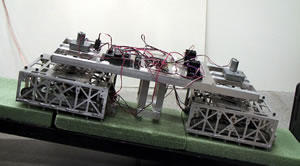Search and rescueSnake-emulating search-and-rescue robot
An all-terrain robot for search-and-rescue missions must be flexible enough to move over uneven surfaces, yet not so big that it is restricted from tight spaces; it might also be required to climb slopes of varying inclines; researchers say the solution would be a search-and-rescue robot which emulates the locomotion of a certain type of flexible, efficient animals: snakes

Scalybot2 uses snake-type locomotion to conserve energy and handle varying terrain // Source: gatech.edu
Designing an all-terrain robot for search-and-rescue missions is a demanding task for scientists. The machine must be flexible enough to move over uneven surfaces, yet not so big that it is restricted from tight spaces. It might also be required to climb slopes of varying inclines. Existing robots can do many of these things, but the majority require large amounts of energy and are prone to overheating. A Georgia Tech release reports that Georgia Tech researchers have designed a new machine by studying the locomotion of a certain type of flexible, efficient animal.
“By using their scales to control frictional properties, snakes are able to move large distances while exerting very little energy,” said Hamid Marvi, a Mechanical Engineering Ph.D. candidate at Georgia Tech.
While studying and videotaping the movements of twenty different species at Zoo Atlanta, Marvi developed Scalybot 2, a robot that replicates rectilinear locomotion of snakes. He unveiled the robot this month at the Society for Integrative & Comparative Biology (SICB) annual meeting in Charleston, South Carolina.
“During rectilinear locomotion, a snake doesn’t have to bend its body laterally to move,” explained Marvi. “Snakes lift their ventral scales and pull themselves forward by sending a muscular traveling wave from head to tail. Rectilinear locomotion is very efficient and is especially useful for crawling within crevices, an invaluable benefit for search-and-rescue robots.”
Scalybot 2 can automatically change the angle of its scales when it encounters different terrains and slopes. This adjustment allows the robot to either fight or generate friction. The two-link robot is controlled by a remote-controlled joystick and can move forward and backward using four motors.
“Snakes are highly maligned creatures,” said Joe Mendelson, curator of herpetology at Zoo Atlanta. “I really like that Hamid’s research is showing the public that snakes can help people.”
Marvi’s advisor is David Hu, an assistant professor in the Schools of Mechanical Engineering and Biology. Hu and his research team are primarily focused on animal locomotion. They have studied how dogs and other animals shake water off their bodies and how mosquitoes fly through rainstorms.
The release notes that this is not the first time Hu’s lab has looked at snake locomotion. Last summer the team developed Scalybot 1, a two-link climbing robot that replicates concertina locomotion. The push-and-pull, accordion-style movement features alternating scale activity.
This project is supported by the National Science Foundation (NSF).
